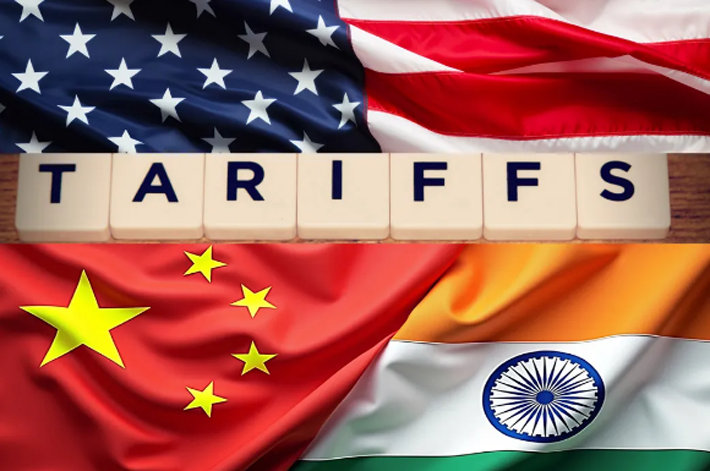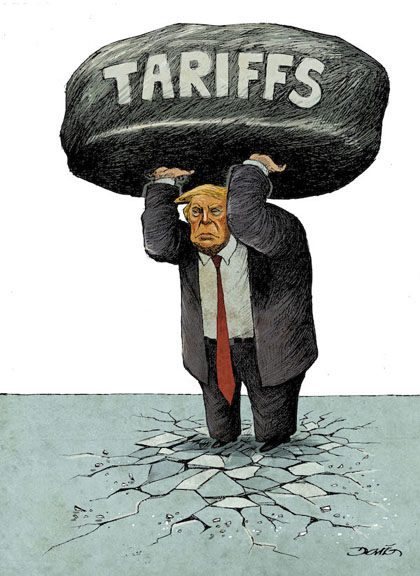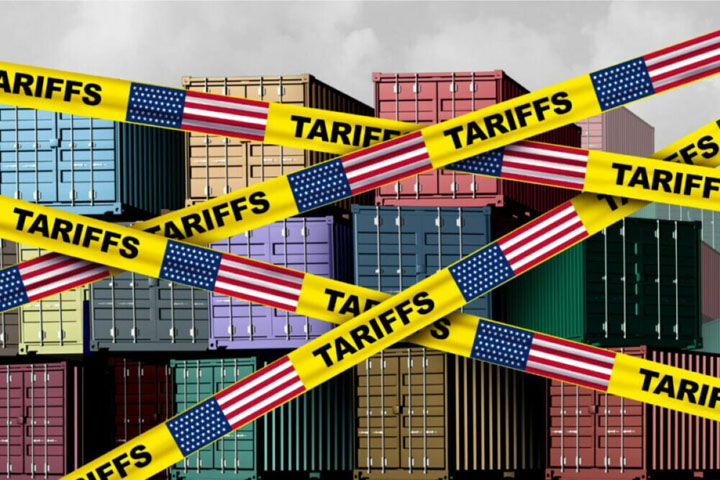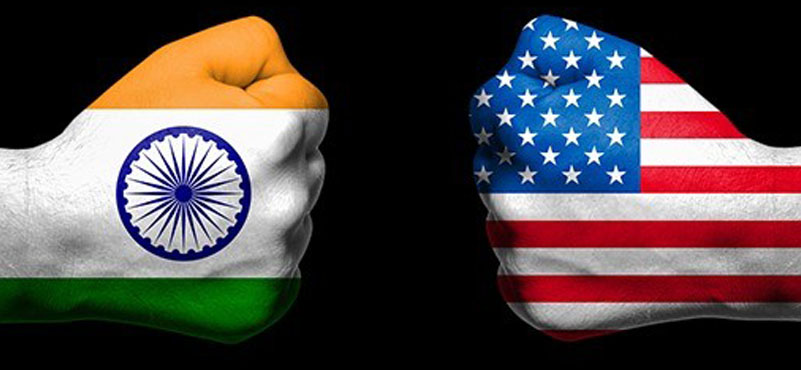Digital Trade and Services Exports
Digital Trade and services have not, so far, featured seriously in the India-US Bilateral Trade Agreement (BTA) negotiations thus far because of its focus on “goods” not services.
India’s total services exports accounted for $387.5 Billion in 2024-25. The US has been pushing for greater access to Indian data since Trump 1.0, challenging India’s strict data localisation norms which require Indian data to be stored within the country. This was a major source of friction between India and the US during that period and, in anticipation of US pressure and retaliation during Trump 2.0, the Indian government eliminated its so called 6% “Google Tax” on payments exceeding Rs 1 lakh (approximately USD 1160) per annum to a non-resident service provider for online advertisement, effective April 2025. This refers to the equalization levy on online digital ads in force since 2016. This cancellation was part of India’s amendments to the Finance Bill 2025.

Canada recently removed all its domestic digital taxes on Google, Meta and other Big Tech companies recently even though Prime Minister Carney says that he was going to do that anyway and it was not because of President Trump and US pressure even though the timing of its withdrawal coincided with Trump’s public threats to Canada on this.
In this instance, unlike on President Trump’s “reciprocal tariffs” in general, it is the European Union (EU), not Canada which is continuing to resist and stand up recently to uphold its regulatory framework and laws to regulate Big Tech: On September 4, it placed a heavy fine of $2.95 billion on Google for violating EU anti-trust rules by distorting competition in advertising. President Trump, unsurprisingly, is up and arms with the EU on this.
India’s services exports have so far been driven by continued global demand for its IT, business, financial and travel services (e.g. telecom, computer and information services, other business services, transport). These service exports have provided significant and consistent growth to India and have significantly contributed to India’s economy. India’s services exports were up by 13.6% in FY 2024-25 from the year earlier to a record $387.5 compared with $341.1 billion in FY 2023-24.
 India is now also emerging as the world’s most significant hub for US and European multinational corporate powered Global Capability Centre’s (GCCs) which have significantly boosted its higher-value-added IT and other service exports in the “Other Business Services” category. This is the emerging silver lining for India in the emerging services export area but employment numbers, even though they are of highly skilled tech qualified Indians employed by the GCCs are only in the tens of thousands, not in the millions needed by the countries. Such GCCs will also further exacerbate inequalities, even within the IT sector, let alone with other service and manufacturing and agricultural product sectors.
India is now also emerging as the world’s most significant hub for US and European multinational corporate powered Global Capability Centre’s (GCCs) which have significantly boosted its higher-value-added IT and other service exports in the “Other Business Services” category. This is the emerging silver lining for India in the emerging services export area but employment numbers, even though they are of highly skilled tech qualified Indians employed by the GCCs are only in the tens of thousands, not in the millions needed by the countries. Such GCCs will also further exacerbate inequalities, even within the IT sector, let alone with other service and manufacturing and agricultural product sectors.
Moreover, of the approximately 100 GCCs in India now, only around the 5-10 in big metropolis’ such as Bengaluru, Chennai, High Tech City near Hyderabad and Gurgaon have really taken off.
More broadly, India’s overall services exports have, thus far, been almost 5 times its goods exports to the US in value terms. After the export neutralizing impacts of the US’ 50% import tariffs fully kick in, assuming, a drop of around $45 billion worth of goods exports to the US then, India’s overall services exports will now be worth almost 10 times more than its goods exports to the US in value terms. As a result, they are poised to become even more important than they already are and will take on even greater significance after the 50% US import tariff impacts on Indian goods to the US kick in. This is particularly worrying and important to note because the US is by far the most significant importer of Indian services, especially its software, IT-enabled and professional services. In fact, the Indian Govt. aims to achieve USD 1 trillion in such service exports by 2030 through policy support and increased investment in the sector.
Recent tax threats by President Trump on major Indian IT corporates Tata Consulting Services (TCS), Hindustan Computers Limited (HCL), WIPRO, Infosys and others located in the US are very worrying in this context for both current and future IT services exports. Threats to cut the predominant share of US H1B visas for Indians are equally, if not, more worrying. So, is talk of the US taxing IT and other back-office service providers located in India and other countries.

The US H1B Visa: Emerging Developments
India currently dominates this category of US visas which have, thus far, had an annual cap of 85,000. Over 70% of this number are reportedly issued to Indians, mainly young Indians in the science, technology, engineering and mathematics (STEM) fields, especially, but also in academia and corporate affairs making them the most visible recipients and targets.
US Commerce Secretary Howard Lutnick has called the H1-B visa program a “scam” telling US businesses that they should be focused on hiring American workers instead of foreigners.
Florida Gov. Ron De Santis “echoed” Lutnick who is directly involved in the overhaul of the H1-B system, calling it a “cottage industry” benefiting Indian workers in a politically charged attack on August 30, in what has recently become a highly politically charged atmosphere, fuelled by the MAGA base, threatening the livelihoods of millions of skilled Indian professionals who have been central to American’s tech and innovation sectors, powering everything from Silicon valley start-ups to critical infrastructure products. This is creating an environment of uncertainty and urgency for both Indian students and professionals in the US.
Marjorie Taylor Greene, Republican MAGA Congresswoman, has added fuel to the fire by calling for the end of H1-B visas, portraying Indian workers as taking American jobs.
Foreign talent is, now, being framed as a threat to American jobs with a particular focus on Indian “cheap labour undercutting” the ‘Hire America’ policy and US wages,” reinforcing anti-immigrant settlement which runs the risk of quickly translating into discriminatory workplace practices.
The replacement of the current H1-B lottery-based system with a more selective model in favour of higher skilled/earning applicants has been on the table since 2020 during Trump 1.0. It was killed by the Biden Administration but has now re-emerged more seriously. It was approved by the White House’s Information and Regulatory Affairs section in early August with an open bias against many Indian professionals and students, many of whom are early in their careers and earn lower salaries than senior US hires. A 4-tier salary-based system was first suggested in 2021. President Trump has also echoed the “cheap labor argument” but also claimed recently that he was on both sides of the argument.
A growing anti-Indian and anti-immigrant narrative may also have been triggered, or at least fuelled, by Indian boasting about many Big Tech and Fortune 500 CEOs being of Indian origin, most of whom first started working in the US on H1-B visas.
The duration of student visas is also being tightened to not exceed four years for undergraduate students with implications and uncertainty about the future of the Optional Practical Training (OPT) post-graduation visa, which is currently 3-years for STEM graduates and one-year for those in the social sciences.
These threats to Indians, especially in the STEM areas, could be both counter-productive and self-defeating for the US because it is hard to separate Indian high-tech talents contribution from that of American high-tech innovation since they are so intertwined and interwoven. An attack on the first is likely to undermine the latter with serious consequences for US global leadership in the high-tech and Artificial Intelligence (AI) areas, much of which is reportedly powered and even led by Americans of Indian-origin or Indians still on H1B visas, not just in Silicon Valley and other US tech cities but also in research and academia.
Nevertheless, if all of this materializes as some of it surely will, especially in the H1B visa component, the impact on the Indian IT and overall services sector and on many Indian students whose long-term career path has been premised on the continuation of both student and H1B visas to the US will be serious and substantial.
ABOUT THE AUTHOR
 Kamal Malhotra is currently Distinguished Visiting Professor at the NALSAR University of Law, Hyderabad, India. He was a Non-Resident Senior Fellow at the Boston University Global Development Policy Center between June 2022-May 2025. He has also Guest Lectured at the School of Interwoven Arts and Sciences (SIAS), Krea University, India. Prior to his retirement from the United Nations in September 2021, Mr. Malhotra had a rich career of over four decades as a management consultant, in senior positions in international NGOs, as co-founder of a think-tank, FOCUS on the Global South, and in the United Nations (UN) including as its Head in Malaysia, Turkiye and Vietnam (2008-21). He was UNDPs Senior Adviser on Inclusive Globalization, based in New York, USA, for most of the prior decade. Mr. Malhotra is widely published.
Kamal Malhotra is currently Distinguished Visiting Professor at the NALSAR University of Law, Hyderabad, India. He was a Non-Resident Senior Fellow at the Boston University Global Development Policy Center between June 2022-May 2025. He has also Guest Lectured at the School of Interwoven Arts and Sciences (SIAS), Krea University, India. Prior to his retirement from the United Nations in September 2021, Mr. Malhotra had a rich career of over four decades as a management consultant, in senior positions in international NGOs, as co-founder of a think-tank, FOCUS on the Global South, and in the United Nations (UN) including as its Head in Malaysia, Turkiye and Vietnam (2008-21). He was UNDPs Senior Adviser on Inclusive Globalization, based in New York, USA, for most of the prior decade. Mr. Malhotra is widely published.








